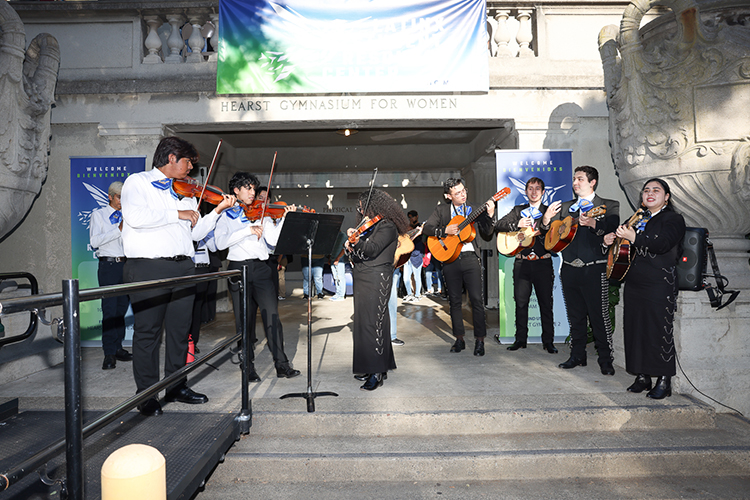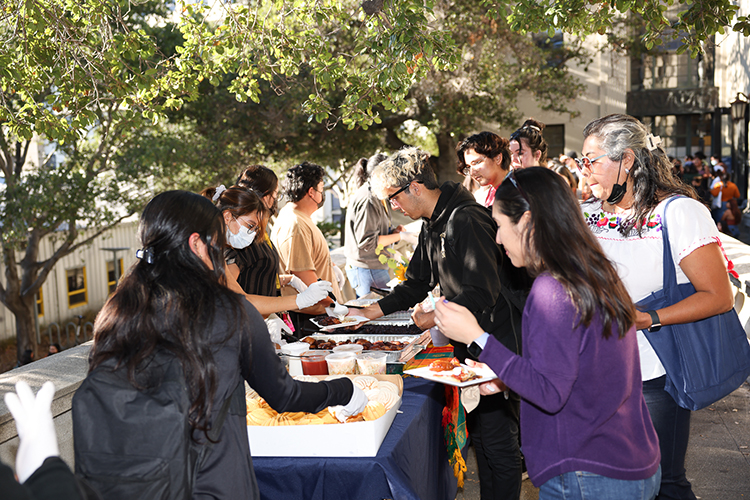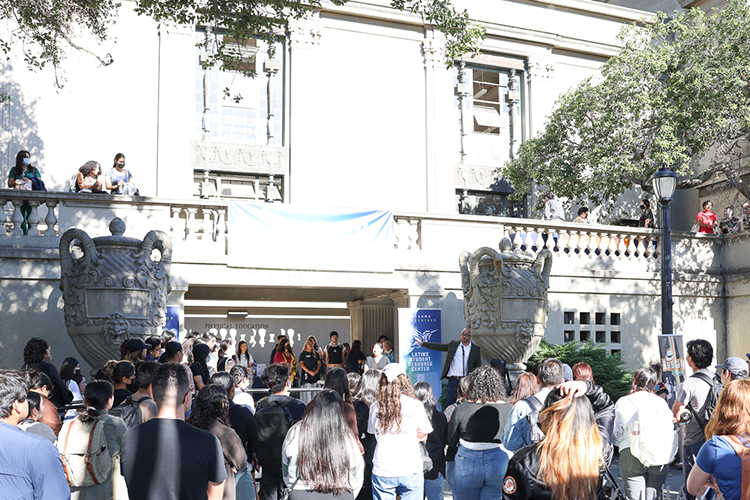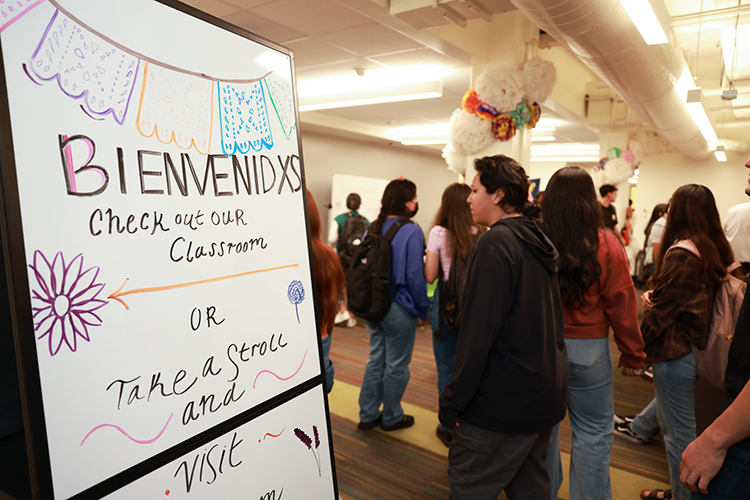Berkeley’s new Latinx Student Resource Center creates family away from home
The campus celebrates the grand opening of UC Berkeley’s new Latinx Community Center

October 14, 2022
When Jade Jaimes-Chavez moved to UC Berkeley in August, she was homesick.
As a first-generation undergraduate Latinx student, and the oldest of three sisters, she grew up taking care of her siblings with a close-knit family in Orange Cove, a predominately Chicanx/Latinx agricultural community in Central California. At Berkeley, she wasn’t sure she belonged, and she missed the support of her family .
Her mother, a Mexican immigrant who worked the fields and packing houses as a farmworker, knew that Berkeley was a vast and expensive university that was very different from Orange Cove. And her daughter would be the first in their family to go off to college, so she was worried too.

Jade Jaimes-Chavez visiting campus with her two younger sisters. (Photo courtesy of Jade Jaimes-Chavez)
That changed when Jaimes-Chavez found UC Berkeley’s Latinx Student Resource Center (LSRC). The space, which also serves as a new home for the Chicanx/Latinx Student Development Office (CLSD), opened at the beginning of the semester and is the first physical community space dedicated for Chicanx/Latinx students on Berkeley’s campus.
Director Lupe Gallegos-Diaz and Assistant Director Gladys Perez offered Jaimes-Chavez and her family resources and support — a “community away from home.”
“They went over a map of the campus and all of the different services Berkeley provides. It was really reassuring and helped the transition for me, and my mom,” said Jaimes-Chavez, who now serves as a communications intern for the center. “It has been great to meet different kinds of people that I’ve never interacted with before. It’s quickly starting to feel like my community away from home.”
That community and sense of family is what Gallegos-Diaz, the LSRC director, said she hopes the center will foster moving forward. Berkeley alumni, staff, faculty and students showed that spirit on Sept. 28, by coming out to celebrate their grand opening.
“I am feeling full of love and energy,” said Gallegos-Diaz. “This center is a culmination of the history of the movement, and our story of love, all coming together from the many different generations that we’ve had here. And we’re here to celebrate that we now have a space where people can come to feel loved, respected and accepted.”
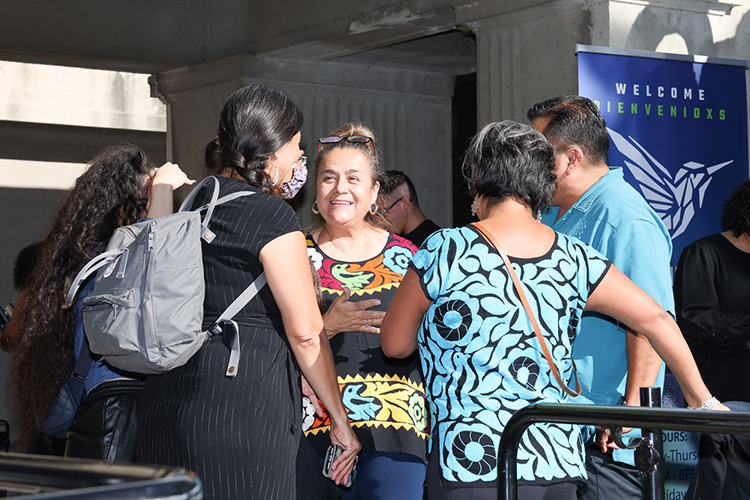
Director of Berkeley’s new Latinx Student Resource Center, Lupe Gallegos-Diaz (center) greeted hundreds of students, staff, faculty and alumni who attended the center’s grand opening on Sept. 28. (Photo by Raul Hernandez)
Located in suite 2 of Berkeley’s Hearst Gymnasium, the over 1,700 square-foot space, also called the Latinx Community Center, will serve not only as a social hub for Berkeley’s Latinx community, but an all-purpose space for student academic support and programing — including counseling, support services, professional networking, and student led classes.
The center will be a home base for the 60 different CLSD interns that Perez will oversee throughout the school year. As LSRC assistant director, Perez said she hopes the center will also become a conduit between the many different communities that Berkeley embodies.
“If communities feel comfortable here and they want to bring other folks here, by all means please do,” said Perez. “We have to be there for one another when it comes to members in the larger BIPOC community. It’s not about hoarding space, it is about sharing what we have with one another. As long as there is mutual respect being practiced, sharing space is an act of community and solidarity.”

The LSRC Assistant Director Gladys Perez. (Photo courtesy of Gladys Perez)
Latinx students for years have advocated for a dedicated space on campus, often gathering instead in the hallways outside Gallegos-Diaz’s small office located at the Cesar E. Chavez Student Learning Center.
Today, the LSRC is one of the many spaces Berkeley leaders hope to ramp up as part of the push to become a Hispanic Serving Institution — a university having at least 25% of enrolled undergraduate students who identify as Latinx.
Vice chancellor for equity and inclusion, Dania Matos hopes the LSRC is one of many resources on campus that will help transform the initiative’s focus to create a campus culture where Latinx students can thrive.
“These centers represent how we can uplift unique experiences and create community across spaces on campus,” said Matos. “We want our students, faculty and staff to go out there into that space and be constantly examining the policies, the practices, the procedures of how we do things in regard to student experience. To give that unique lens of how structural practices impact different communities in different ways.”
Berkeley professor Pablo Gonzalez was an undergraduate on campus in the 1990s and said having a center for Latinx students to gather has been a long time coming. But the space is also an opportunity for staff, faculty and alumni to come down from their offices and interact with the students that they serve every day.
“The point of a location like this is about people being able to encounter each other, and to debate, have conversations, study, learn, build and organize,” said Gonzalez. “We are in dire need of organizers to think about, not only the restructuring of this university, but our world in general. … A place like this can be a spark that hopefully will manifest into policy and practice that shows care for the community and its ancestors.”

Berkeley graduate student Adan Martinez speaks at the LSRC grand opening. Martinez hopes the center supports more collaborations on campus between graduate and undergraduate students. (Photo by Raul Hernandez)
The center’s grand opening was one of several celebrations Gallegos-Diaz and her team held to honor the rich history of Berkeley’s Latinx community. Held on Oct. 1 and 2, Latinx Legacy Weekend was hosted by Berkeley’s Chicanx Latinx alumni association and student development center, and brought together generations of Berkeley alumni and students to remember the arduous work it has taken over the years to open the LSRC.
Berkeley student-parent Esau Torres attended the weekend of festivities and said Gallegos-Diaz continues to be as invaluable to Berkeley’s Latinx community as she was in the past.
“Lupe is a leader and a rock star that wants the students she serves to be rock stars too,” said Torres. “Berkeley can be an intimidating place for students like me. But having this center, and people like Gladys, Evelyn and Lupe here, who welcomes you like your family — your heart fills up and your arms spread out. It’s like you have wings, and you want to do anything you can to help them continue that legacy.”
